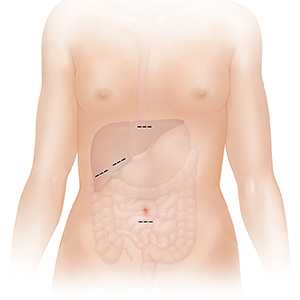Having Laparoscopic Cholecystectomy
You’ve had painful attacks caused by gallstones. Because of this, you are having surgery to remove your gallbladder. This is called cholecystectomy. A method called laparoscopy will be used. This allows surgery to be done through a few small cuts (incisions).
 |
| Possible incision sites. |
Before your surgery
-
Tell your health care provider what medicines you take. This includes prescription medicines, over-the-counter medicines, illegal drugs, herbs, vitamins, and other supplements. Be sure to mention if you take prescription blood thinners. This includes warfarin, clopidogrel, lovenox, rivaroxaban, edoxaban, apixaban, and dabigatran. Also tell your provider if you take NSAIDs, such as naproxen, ibuprofen, or aspirin. You may be asked to stop taking certain medicines several days before surgery.
-
If you drink alcohol, tell your provider how much you drink. This is very important if you are a heavy drinker or have had alcohol withdrawal symptoms in the past. Alcohol withdrawal can be dangerous. But the symptoms can be safely managed if your provider knows your alcohol history.
-
Have any tests your provider asks for, such as blood and urine tests and an electrocardiogram (ECG).
-
Don’t eat or drink after midnight the night before your surgery. This includes water, coffee, and mints.
-
Wash with a special scrub, if you are told to do so.
The day of surgery
When you arrive, you will prepare for surgery:
-
An I.V. (intravenous) line will be put into a vein in your arm or hand. This I.V. line is the way you are given fluids and medicine.
-
An anesthesiologist will talk with you about your health history and the anesthesia you will get during the procedure. You will likely receive general anesthesia, which allows you to sleep comfortably throughout the procedure.
During laparoscopic surgery
For this surgery, a thin tube with a tiny camera is used. This is called a laparoscope. The scope sends images from inside your body to a video screen. This lets the surgeon view and work on your gallbladder.
-
Small incisions are made in your belly (abdomen). The scope is put through one of the incisions. Surgical tools are put through other incisions.
-
Small clips are used to close off the connection between the gallbladder and the bile duct. The gallbladder is then detached from the liver.
-
The gallbladder is removed through one of the incisions. Bile still flows from the liver to the small intestine.
-
When the surgery is done, all tools are removed. Incisions are closed with stitches (sutures), surgical glue, or staples.
-
Your surgeon may have done this procedure using a surgical robot. The surgeon guides a special robot instead of guiding the surgical tools by hand. This is commonly called robotic surgery. It uses several small incisions, and the recovery is generally the same as with laparoscopy.
Sometimes, a laparoscopic surgery may need to be changed to an open surgery. This method uses one large incision. This change may happen because of scar tissue, unusual anatomy, or for some other unexpected reason.
After surgery
You will be sent to the postanesthesia care unit (PACU) to be closely monitored. You will likely go home the same day. In some cases, an overnight stay for observation is needed. When you are released to go home, have a family member or friend ready to drive you. Follow all post-op instructions given by your provider. This may include not driving, working, or lifting heavy objects for a period of time.
Risks of this surgery
All surgeries have risks. The risks of gallbladder surgery include:
-
Bleeding.
-
Infection.
-
Injury to the common bile duct or nearby organs.
-
Blood clots in the legs or lungs.
-
Bile leaks.
-
A hernia at the incision site.
-
Pneumonia.
Online Medical Reviewer:
Jen Lehrer MD
Online Medical Reviewer:
Melinda Murray Ratini DO
Online Medical Reviewer:
Rita Sather RN
Date Last Reviewed:
2/1/2025
© 2000-2025 The StayWell Company, LLC. All rights reserved. This information is not intended as a substitute for professional medical care. Always follow your healthcare professional's instructions.